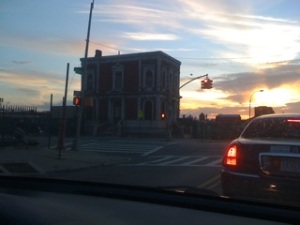Next performance of State of the Sea at Issue Project Room, Brooklyn, NY
July 22, 2010
for oceanographic observations off the coast of Massachusetts:
Martha’s Vineyard Coastal Observatory
A proposal by Barbara Held, commissioned by and realized with the technical support of the Orquesta de Caos and the collaboration of Jorge Guillen and Marta Martinez of the Institut de Ciencies del Mar, CMIMA
Festival Zeppelin, 2009, Friday, December 11 at 9 PM
Centre Mediterrani d’Investigacions Marines i Ambientals del CSIC
From the beaches in front of the Barcelona Olympic Harbour, a number of permanent devices continuously measure different parameters of the coastal zone. Every daylight-hour the cameras get one picture per second for a ten-minute period (see photos and monthly movie), and wave and current data is gathered.
Notes on State of the Sea – About measuring and naming, scientific and artistic study
When the Zeppelin Festival 2009 invited me to perform with their 8-channel sound system, a series of events lead me to a meditation on nature and technology. While listening to the weather report on my car radio, for the first time I noticed that the state of the sea, the “estat del mar”, was included in the weather forecast. “Marejol”, such a beautiful word to name a certain waviness of the sea. I investigated a bit more, and found that scientists have developed the Douglas Scale, an international table of categories to name the states of the sea in the major European languages, and in keeping with the character of each language, the names sound more or less poetic. The categories for “wind sea” in Italian, for example, (quasi calmo, molto agitato, molto grosso) sound like music notation, and in Catalan they appear to come from the traditional terms used by seagoing people. I also recalled reading the news about a giant wave (26,13 meters) that was measured off the coast of Santander during one of last winter’s major storms. The buoy belonging to the Instituto Español de Oceanografía (IEO) that made the measurement was actually broken from its mooring and carried away as far as San Sebastian. Scientists of the sea are constantly measuring the levels and movements of water, and that data is available online. The Coastal Monitoring Station of Barcelona, ICM-CSIC, maintains a system of a number of permanent devices continuously measuring different parameters of the coastal zone and systematic (monthly) surveys assessing environmental factors. This information is available as a series of daily photographs of a segment of the coastline, a monthly composite movie, as well as numerical data and graphs. The scientists who are using the data received from the system of buoys up and down the Catalan coast have made it available to me to use in this piece. Interestingly, Jorge Guillen of the Institut de Ciencies del Mar, CMIMA, is a specialist in beaches, the “line” between the dry land and the sea.
Specialists in acoustics use sensitive instruments to measure and record the resonance of real spaces in order to reproduce them digitally and create recordings of music or movie sound tracks that sound more realistic, approaching 3D sound. I was fascinated to discover that the special microphones and sensors that are used to capture the reverberation of an architectural space use heat to measure acoustic particle velocity, a translation of data that is similar to the way marine scientists measure the pressure of water in order to calculate the height of waves.
For the past three months I have been living with a beautiful book called Goethe & Palladio, Goethe’s study of the relationship between art and nature, leading through architecture to the discovery of the metamorphosis of plants. Goethe and Palladio, David Lowe/Simon Sharp, Lindesfarne Books, 2005
Inspired by the poet Goethe’s scientific approach of “knowing – from the inside”, so similar in spirit to Pauline Oliveros’ life-long practice of deep listening, I have approached the creation and performance of the State of the Sea as a classically trained flutist exploring natural acoustic space, as well as the electronic synthesis and reproduction of sound by using “real seeing/listening” – what Goethe called an “exact sensory imagination”, basic to both scientific and artistic study.
State of the Sea is a sonification of data from measurements of the sea including the famous storm in December of 2008 that reshaped the beaches of Barcelona. The data creates sound and controls the volume or movement of music through a multi-speaker system, translating one kind of natural movement into another perception of movement, sound vibrations, interacting in architectural space. In his Quattro Libri, Palladio defines architecture as “the transformation of space”. Music, as in all the creations of nature, is perceived as a “vibrant field of formative processes”. (Gordon L. Miller, Introduction to Goethe’s The Metamorphosis of Plants, MIT Press, p. viv)
“When man’s nature functions soundly as a whole, when he feels that the world of which he is part is a huge, beautiful, admirable and worthy whole, when this harmony gives him pure and uninhibited delight, then the universe, if it were capable of emotion, would rejoice at having reached its goal and admire the crowning glory of its own evolution. For, what purpose would those countless suns and planets and moons serve, those stars and milky ways, comets and nebulae, those created and evolving worlds, if a happy human being did not ultimately emerge to enjoy existence?” (Goethe, Essays on Art, p101)
Many thanks to Carlos and Elmer, Stephan Moore, Sam Roig, Jorge Guillen and Marta Martinez, Oscar Chic, Pauline Oliveros, Nil Tous.

More Links:
The State of the Sea
The “wind sea” is the motion of the waves generated by the wind blowing directly on the observed sea area or in its immediate vicinity
“Color is less a trope of indeterminacy than a way to re-create an almost visceral experience of our impossible desire to name our perceptions.”
Spencer Finch
Het Visboek, Adriaen Coenen
16th century scientific observation of the creatures of the sea.










